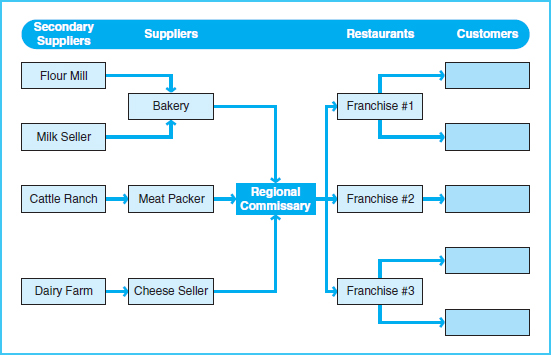BUSINESS PROCESS LINKAGE THROUGHOUT THE SUPPLY CHAIN (STUDY OBJECTIVE 3)
The accounting information system and the reports generated by the system are intended to help management monitor and control the organization. However, any organization operates in an environment in which it has many interactive relationships with other organizations. For example, McDonald's could not operate without its relationships with the many suppliers that provide the ingredients for its menu selections. There is an entire set of activities (business processes) that culminate when McDonald's sells a Big Mac® to a customer. Consider the road that leads to this culminating sale—it stretches far back into many other organizations. To illustrate these activities, let's trace just a small part of that Big Mac sale back as far as we can reasonably go. In order to sell a Big Mac, McDonald's had to purchase and keep an inventory of hamburger meat. McDonald's would have purchased this meat from a meat supplier called a vendor. A vendor provides materials or operating supplies to an organization. The terms “vendor” and “supplier” are usually used interchangeably.
For the McDonald's meat vendor to supply meat, that vendor had to buy cattle to process into raw meat. Therefore, McDonald's meat supplier must have relationships with vendors that sell cattle. The cattle seller can be called a secondary supplier to McDonald's. To trace back one step farther, we could say that the cattle seller had to buy cattle from a rancher who raised cattle.
Likewise, the bun on the Big Mac can be traced back to a bakery, which had to purchase flour from another company, and that flour producer needed wheat to produce flour. Tracing back one step farther, we find that the wheat was sold by a wheat farmer. You might wonder what the purpose is of tracing a Big Mac back to the rancher who raised cattle and the farmer who grew wheat. The point is that for McDonald's to operate efficiently, each of these interactive relationships between buyer and seller must operate efficiently. For example, a labor union strike at a bakery could interrupt the supply of buns for McDonald's. Therefore, the top management at McDonald's must ensure that it properly manages, monitors, and controls the internal processes, as well as those processes that are linked to outside parties such as vendors. McDonald's may not be able to directly control all of these interrelated activities stretching back through the many suppliers, but McDonald's may be able to influence those activities by the suppliers they choose and the expectations they place on those suppliers in terms of price, quality, and delivery timing. This set of linked activities is called the supply chain. The supply chain is the entities, processes, and information flows that involve the movement of materials, funds, and related information through the full logistics process, from the acquisition of raw materials to the delivery of finished products to the end user. The supply chain includes all vendors, service providers, customers, and intermediaries.
The concept of monitoring and controlling the linked set of activities in the supply chain is called supply chain management. Supply chain management is the organization and control of all materials, funds, and related information in the logistics process, from the acquisition of raw materials to the delivery of finished products to the end user (customer). A simplified view of a supply chain for McDonald's is shown in Exhibit 1-2.
The management at McDonald's would find it in the best interest of its company to closely manage, monitor, and control the processes within the supply chain as much as possible. For example, a large organization such as McDonald's can demand certain levels of quality from the bakery that supplies buns. In addition, McDonald's can apply pressure to make sure that the bakery has reliable suppliers of high-quality flour. To the extent that McDonald's can influence primary and secondary suppliers to maintain quality of supplies and efficiency of operations, the business processes within McDonald's will operate more smoothly. As an example, McDonald's bun purchasing process will operate more efficiently when the bakery's bun selling processes run efficiently. This connection between the purchasing processes used by McDonald's and the supplier's selling processes represents a supply chain linkage. In order to increase the efficiency and effectiveness of these supply chain linkages, many organizations employ IT systems. Using IT systems to enhance efficiency and effectiveness of internal or supply chain processes is called IT enablement.
THE REAL WORLD
An organization such as McDonald's must have many different suppliers of the same product because of the need for fresh ingredients. For example, the regional bakery in the next exhibit provides buns for McDonald's in a five-state area.
As you have traveled, you may have noticed that your Big Mac is always the same, no matter where you go. Even the buns are exactly the same in each town and city. McDonald's plans for this uniformity in buns and must have many suppliers throughout the world that can make and deliver a consistent quality bun.
East Balt, Inc., is one of the large bakeries that supplies McDonald's with buns. East Balt bakeries make these buns according to strict standards of size, shape, color, height, and seed coverage. To maintain freshness, the buns have to be baked in regional locations. It would be much too difficult to have one central location bake all buns for McDonald's. Therefore, McDonald's must have many different suppliers of buns throughout the world.
Exhibit 1-2 A Simplified Supply Chain for McDonald's

